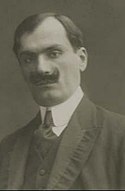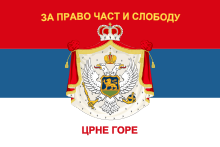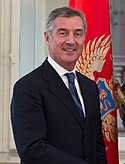The early written records of the history of Montenegro begin with Illyria and its various kingdoms until the Roman Republic incorporated the region into the province of Illyricum after the Illyro-Roman Wars.

Svetozar Marović is a Montenegrin lawyer and politician who served as the last head of state and head of government of Serbia and Montenegro from 2003 until Montenegro's declaration of independence in 2006.
The Democratic Party of Socialists of Montenegro is a social-democratic and populist political party in Montenegro. A former long-time ruling party sitting at the opposition for the first time as of 2020, it was formed on 22 June 1991 as the successor of the League of Communists of Montenegro, which had governed Montenegro within the Socialist Federal Republic of Yugoslavia since World War II, and has remained a major force in the country ever since. The party is a member of the Socialist International and the Progressive Alliance, and an associate of the Party of European Socialists. During the 1990s, DPS was the major centre-left, social-democratic party in favour of Serbian-Montenegrin unionism. However, since 1997, the party has embraced Montenegrin independence and has been improving ties with the West, slowly turning into a catch-all party embracing Atlanticism, Montenegrin nationalism, neoliberalism, and pro-Europeanism.

Milo Đukanović is a Montenegrin politician who served as the President of Montenegro from 2018 to 2023, previously serving in the role from 1998 to 2002. He also served as the Prime Minister of Montenegro and was the long-term president of the Democratic Party of Socialists of Montenegro, originally the Montenegrin branch of the League of Communists of Yugoslavia, which governed Montenegro alone or in a coalition from the introduction of multi-party politics in the early 1990s until its defeat in the 2020 parliamentary election. He is the longest-ruling contemporary politician in Europe, having held key positions in the country for over 33 years. However, he was defeated by the 36-year-old centrist former economy minister, Jakov Milatović, after the presidential run-off held on 2 April 2023.

Montenegrins are a South Slavic ethnic group that share a common ancestry, culture, history, and language, identified with the country of Montenegro.

Momir Bulatović was a Yugoslav and Montenegrin politician. He was the first President of the Republic of Montenegro from 1990 to 1998, after which he served as the Prime Minister of the Federal Republic of Yugoslavia from 1998 until 2000, when Slobodan Milošević was overthrown. He was a leader of the Montenegro's Democratic Party of Socialists from 1989 to 1997, when he split from DPS after a conflict with Milo Đukanović.
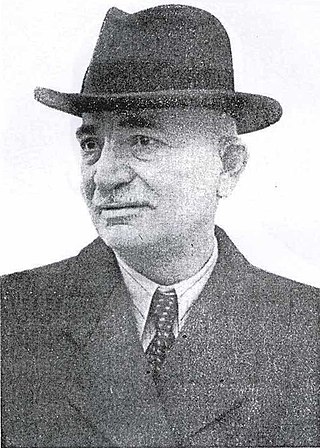
Sekula Drljević was a Montenegrin nationalist, Yugoslav jurist, politician, orator, and theoretician. During World War II, he was a collaborator with the Ustaše in the German puppet state of the Independent State of Croatia.

After a period of political and economic crisis in the 1980s, constituent republics of the Socialist Federal Republic of Yugoslavia split apart, but the unresolved issues caused a series of inter-ethnic Yugoslav Wars. The wars primarily affected Bosnia and Herzegovina, neighbouring parts of Croatia and, some years later, Kosovo.

Croatian nationalism is nationalism that asserts the nationality of Croats and promotes the cultural unity of Croats.
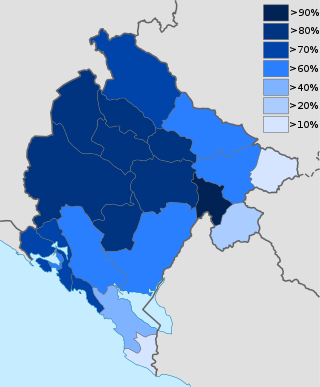
The 1992 Montenegrin independence referendum was the first referendum regarding Montenegrin independence, held on 1 March 1992 in SR Montenegro, a constituent republic of the Socialist Federal Republic of Yugoslavia.

Amfilohije was a bishop of the Serbian Orthodox Church, theologian, university professor, author and translator. He was first the Bishop of Banat between 1985 and 1990, and then the Metropolitan Bishop of Montenegro and the Littoral from 1990, until his death. As the metropolitan bishop, he was the primate of the Serbian Orthodox Church in Montenegro. He was one of the most influential leaders of the Serbian Church, and was among the three candidates for the Serbian patriarchate.
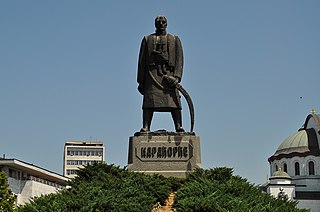
Serbian nationalism asserts that Serbs are a nation and promotes the cultural and political unity of Serbs. It is an ethnic nationalism, originally arising in the context of the general rise of nationalism in the Balkans under Ottoman rule, under the influence of Serbian linguist Vuk Stefanović Karadžić and Serbian statesman Ilija Garašanin. Serbian nationalism was an important factor during the Balkan Wars which contributed to the decline of the Ottoman Empire, during and after World War I when it contributed to the dissolution of the Austro-Hungarian Empire, and again during the breakup of Yugoslavia and the Yugoslav Wars of the 1990s.

The Greens were a group of loyalists of King Nikola of Montenegro. They originated from the members of the True People's Party and were most notable for instigating the Christmas Uprising of 1919. The rebellion was staged in an attempt to prevent the dethroning of the Petrović-Njegoš dynasty and the subsequent integration of Montenegro into the Kingdom of Yugoslavia. The Greens were supporters of the House of Petrović-Njegoš, which once the house was dethroned after World War I, led the Greens to fight for the establishment of Montenegro as a province within the Yugoslav kingdom. Following their defeat in the Christmas Rebellion, the Greens continued on with their guerrilla warfare until 1929. The motto of the movement was "For the Right, Honour and Freedom of Montenegro".

The Montenegrin Federalist Party, sometimes known simply as the Montenegrin Party, was a Montenegrin political party in the Kingdom of Yugoslavia which stood for preservation of Montenegrin autonomy and a decentralized federalised Yugoslavia. It pursued the ideology of the Greens who lost the Christmas Uprising, but in a peaceful and democratic manner. Its best known leader was Sekula Drljević.

The Italian governorate of Montenegro existed from October 1941 to September 1943 as an occupied territory under military government of Fascist Italy during World War II. Although the Italians had intended to establish a quasi-independent Montenegrin kingdom, these plans were permanently shelved after a popular uprising in July 1941. Following the Italian surrender in September 1943, the territory of Montenegro was occupied by German forces which withdrew in December 1944.
Novak Kilibarda, PhD was a Montenegrin politician, professor, literary historian and writer.

Bosniak nationalism or Bosniakdom is the nationalism that asserts the nationality of Bosniaks and promotes the cultural unity of the Bosniaks. It should not be confused with Bosnian nationalism, often referred to as Bosniandom, as Bosniaks are treated as a constituent people by the preamble of Constitution of Bosnia and Herzegovina, whereas people who identify as Bosnians for nationality are not. Bosniaks were formerly called Muslims in census data but this model was last used in the 1991 census.

Montenegrin–Serbian relations are foreign relations between Montenegro and Serbia. From 1918 until 2006, the two states were united under the Kingdom of Yugoslavia, the Socialist Federal Republic of Yugoslavia, and Serbia and Montenegro. There is controversy regarding the national identity of Montenegro due to recent political developments in the region. There is a debate on the ethnic identification of Montenegrins, and the name of the national language. Despite this, the two countries have maintained mostly friendly relations.
Controversy over ethnic and linguistic identity in Montenegro is an ongoing dispute over the ethnic and linguistic identity of several communities in Montenegro. There are several points of dispute, some of them related to identity of people who self-identify as ethnic Montenegrins, while some other identity issues are also related to communities of Serbs of Montenegro, Croats of Montenegro, Bosniaks of Montenegro and ethnic Muslims of Montenegro. All of those issues are mutually interconnected and highly politicized.

Serbs of Montenegro or Montenegrin Serbs, compose native and the second largest ethnic group in Montenegro, after the ethnic Montenegrins. Additional 0.64% of the population is made up of Serbs-Montenegrins and Montenegrins-Serbs.


